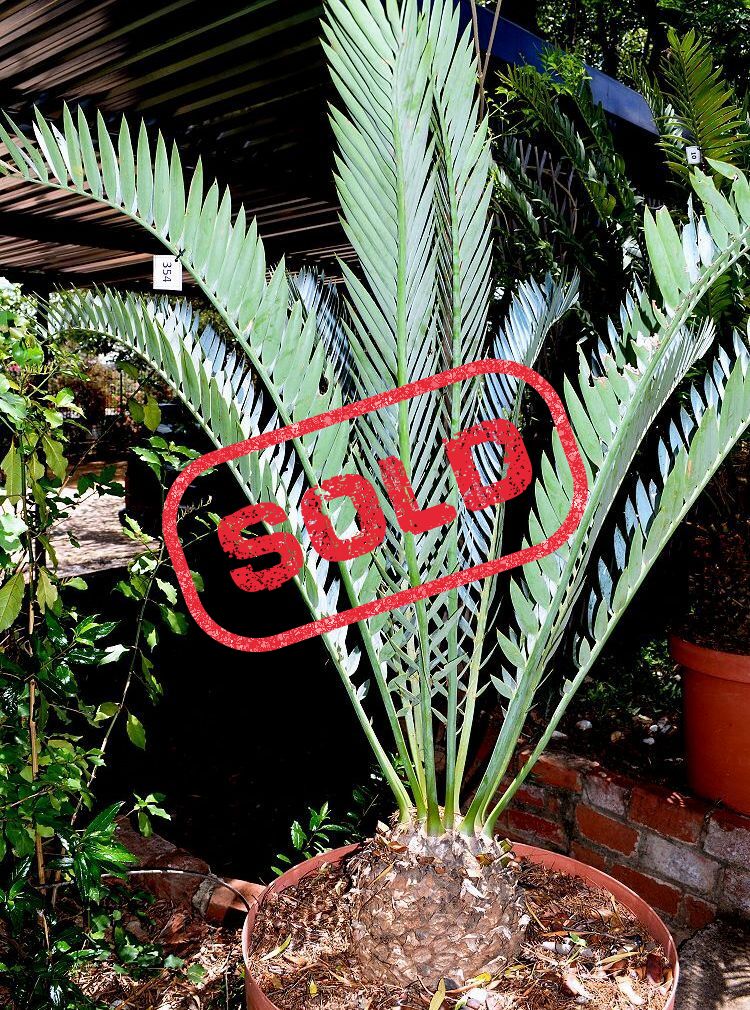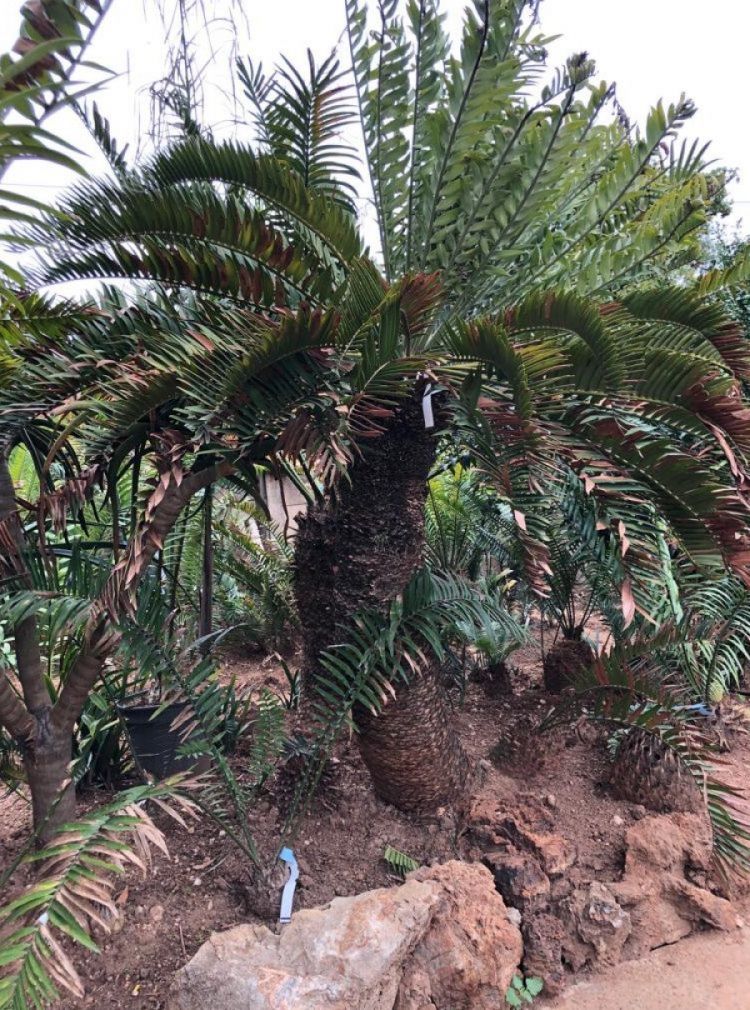|
| Division: Cycadophyta |
| Class: Cycadopsida |
| Order: Cycadales |
| Family: Zamiaceae |
| Genus: Encephalartos |
| Species: E. longifolius |
Conservation Status: |

E. longifolius
Suurberg CycadEncephalartos longifolius, also known as the Suurberg Cycad or Thunberg's Cycad, is a low-growing palm-like cycad that is endemic to South Africa. The species name comes from the Latin longis, long and folius, leaf. This species is found in coastal regions of Eastern Cape Province, South Africa growing at heights of up to six hundred metres. It grows in a variety of different habitats on the mountain ridges from west of Joubertina in the Kouga mountains east to near Grahamstown. There are a large number of locations where breadpalms grow but on the whole, populations are declining.
Interesting Note: This was the first cycad seen by the early colonists pushing eastwards. This was Thunberg's breadtree; and this species almost changed the course of South African history for its seeds nearly killed General Smuts and men of a Boer commando in the eastern Cape during the Anglo-Boer War. Colonel Deneys Reitz writes in his book Commando how Smuts and his men, camping on the Suurberg, were poisoned after eating the seeds of Encephalartos altensteinii. Botanists today know that Reitz mistook the species, and that it was Thunberg's breadtree that poisoned the party.
The stems, which are mostly erect, can reach a height of 4.5 m. Branching rarely occurs, but up to 10 stems may originate from the base.
The young leaves are covered in fine hairs that disappear later. The leaves are 1-2 m in length and are mostly glossy and dark green. The last third of the leaf curves strongly downwards giving the crown a relatively compact umbrella shape. The leaflets may be moderately spaced, but can sometimes overlap and they can be up to 200 mm long. The edges of the leaflets are normally smooth but can sometimes have 1-3 teeth on the lower margin. The tip terminates in a sharp spine or it can be rounded.
Encephalartos longifolius cones are very large and are of the heaviest of all the South African cycads, with female cones weighing up to 36 kg. The male plants bear up to 3 greenish brown cones that are 400-600 x 150-200 mm. The females bear 1 (rarely 2) olive-green cones that are 500-600 x 400 mm.
Cultivation:
Encephalartos longifolius is suitable for container planting and is a great feature plant in a garden. It is suited to temperate and cool subtropical regions. Mature plants prefer full sun and they may tolerate light frosts. They prefer a moderately acid, well-drained sandy-loam soil. Do not over-water as most cycads are susceptible to root rot. This can spread to the rest of the plant if it is not stopped in time. Cycads require regular feeding with a balanced inorganic fertilizer. Mulching with compost or manure will improve soil condition and add extra nutrition.
Seed can be propagated in spring in seedling trays filled with clean river sand and kept in an area where temperatures of between 25-28°C are maintained. Remove the fleshy outer layer from the seed by soaking in water for a few days. Rub off this layer and let the seeds dry. Use gloves during this process as this soft layer contains toxins. Germination takes place over 3-6 months, after which the seedlings should be carefully removed and planted in plastic growing bags filled with a well-drained medium. When they are large enough (approximately 2 years), plant in large pots or in the garden.
Mealy bugs and scale are the main pests of cycads in cultivation but they can be controlled with a systemic insecticide. Cycad cones attract snout beetles that often destroy the seeds. Spray the cones with a contact insecticide if these beetles are noticed. It is recommended that a contact insecticide be applied regularly when new leaves are noticed as a tiny gall midge favours the newly emerging leaves and can destroy them.
Recipe for a suitable growing medium:
| full sun | blue-green | low watering | average growth | frost-resistant | common |
Encephalartos longifolius is suitable for container planting and is a great feature plant in a garden. It is suited to temperate and cool subtropical regions. Mature plants prefer full sun and they may tolerate light frosts. They prefer a moderately acid, well-drained sandy-loam soil. Do not over-water as most cycads are susceptible to root rot. This can spread to the rest of the plant if it is not stopped in time. Cycads require regular feeding with a balanced inorganic fertilizer. Mulching with compost or manure will improve soil condition and add extra nutrition.
Seed can be propagated in spring in seedling trays filled with clean river sand and kept in an area where temperatures of between 25-28°C are maintained. Remove the fleshy outer layer from the seed by soaking in water for a few days. Rub off this layer and let the seeds dry. Use gloves during this process as this soft layer contains toxins. Germination takes place over 3-6 months, after which the seedlings should be carefully removed and planted in plastic growing bags filled with a well-drained medium. When they are large enough (approximately 2 years), plant in large pots or in the garden.
Mealy bugs and scale are the main pests of cycads in cultivation but they can be controlled with a systemic insecticide. Cycad cones attract snout beetles that often destroy the seeds. Spray the cones with a contact insecticide if these beetles are noticed. It is recommended that a contact insecticide be applied regularly when new leaves are noticed as a tiny gall midge favours the newly emerging leaves and can destroy them.
Recipe for a suitable growing medium:
- 4 shovels clean, coarse, river sand
- 4 shovels milled pine bark
- 2.5 shovels loam
- 40 g dolomite or dolomitic lime
- 3 g iron sulphate
- Include a balanced, slow-release fertilizer at the rate stipulated on the product.
E. longifolius for sale at AfricaCycads.com:
|
|
|
| ||||
|





